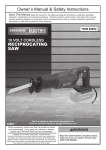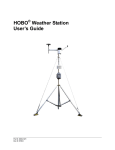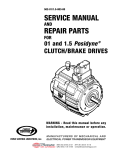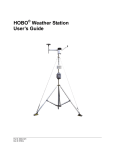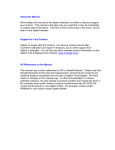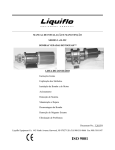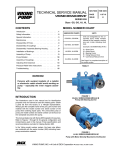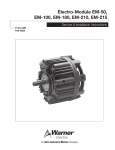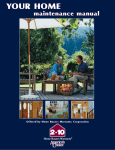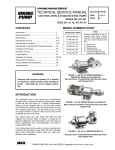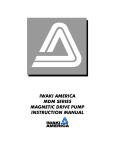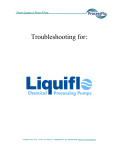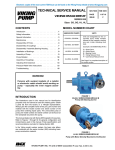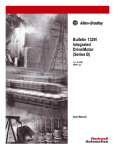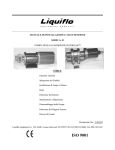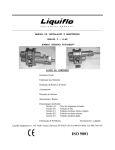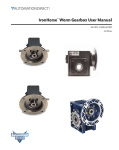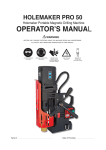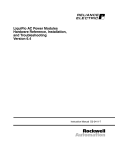Download INSTALLATION, OPERATION and MAINTENANCE - firma-web
Transcript
TM INSTALLATION, OPERATION and MAINTENANCE MANUAL ROTOGEAR® MAGNETIC-DRIVE PUMPS 3-SERIES: Models 31F, 33F, 35R, 35F, 37R, 37F, 39R, 39F & 311F - MC H-SERIES: Models H3F, H5R, H5F, H7N, H7R & H7F - MC Table of Contents Section 1: Section 2: Section 3: Section 4: Section 5: Forward . . . . . . . . . . . . . . . . . . . . . . . . . . . . . 2 General Information . . . . . . . . . . . . . . . . . . . 3-8 Safety Precautions . . . . . . . . . . . . . . . . . . . . 9 Pump & Motor Installation . . . . . . . . . . . . . . 10-12 Start-Up & Operation . . . . . . . . . . . . . . . . . . 13 Maintenance & Repair . . . . . . . . . . . . . . . . . 14-30 Appendix . . . . . . . . . . . . . . . . . . . . . . . . . . . . 31-47 © June 2005 Liquiflo, All rights reserved 443 North Avenue, Garwood, NJ 07027 USA Document No.: 3.20.074 Tel: 908-518-0777 Fax: 908-518-1847 www.liquiflo.com Rotogear® Magnetic-Drive Pumps Models 31-39, 311 & H3-H7 - MC Liquiflo Installation, Operation & Maintenance Manual Forward This manual provides instructions for the installation, operation and maintenance of the Rotogear® 3 & H Series gear pumps, Mag-Drive Models 31F, 33F, 35R, 35F, 37R, 37F, 39R, 39F, 311F, H3F, H5R, H5F, H7N, H7R & H7F. It is critical for any user to read and understand the information in this manual along with any documents this manual refers to prior to installation and start-up. Liquiflo shall not be liable for damage or delays caused by a failure to follow the instructions for installation, operation and maintenance as outlined in this manual. These pumps are not warranted for service other than those specified on the order by Liquiflo applications engineering. If it is desirable to use this product for alternative services, please call Liquiflo applications engineering or your local Liquiflo distributor. Thank you for purchasing a Liquiflo product. LIQUIFLO STANDARD TERMS AND CONDITIONS APPLY UNLESS SPECIFIED IN WRITING BY LIQUIFLO. Detailed Table of Contents 1. General Information 1.1 1.2 1.3 1.4 1.5 1.6 1.7 1.8 1.9 5. Maintenance & Repair General Instructions . . . . . . . . . . . . . . . . . . . 3 Pump Specifications . . . . . . . . . . . . . . . . . . . 4-6 Model Coding . . . . . . . . . . . . . . . . . . . . . . . . 6 Pump Installation. . . . . . . . . . . . . . . . . . . . . . 7 Start-Up . . . . . . . . . . . . . . . . . . . . . . . . . . . . . 7 Operation & Troubleshooting . . . . . . . . . . . . 7 Maintenance & Repair. . . . . . . . . . . . . . . . . . 7 Repair Kits & Replacement Parts . . . . . . . . . 7 Returned Goods Authorization (RGA) . . . . . 8 2. Safety Precautions 2.1 General Precautions . . . . . . . . . . . . . . . . . . . 9 2.2 Precautions for Magnetic-Drive Pumps . . . . 9 3. Pump & Motor Installation 3.1 3.2 3.3 3.4 Installation of Pump, Motor and Base. . . . . . 10 General Piping Requirements . . . . . . . . . . . . 10 Gear Pump Requirements . . . . . . . . . . . . . . . 11 General Motor Requirements . . . . . . . . . . . . 11-12 3.4.1 Motor Selection. . . . . . . . . . . . . . . . . . 11 3.4.2 Motor Hook-Up. . . . . . . . . . . . . . . . . . 12 3.4.3 Motor Direction. . . . . . . . . . . . . . . . . . 12 4. Start-Up & Operation 4.1 Precautions Prior to Starting Pump . . . . . . . . 13 4.2 Operating Requirements . . . . . . . . . . . . . . . . 13 4.3 Troubleshooting. . . . . . . . . . . . . . . . . . . . . . . 13 2 5.1 Work Safety . . . . . . . . . . . . . . . . . . 14 5.2 Removal from System . . . . . . . . . . 14 5.3 Pump Disassembly . . . . . . . . . . . . . 15-19 Cartridge Removal . . . . . . . . . . . . . 15 Gear-Shaft Disassembly . . . . . . . . . 17-18 Removal of Bearing Lock Pins. . . . 18 Removal of Bearings . . . . . . . . . . . 18 Removal of Outer Magnet . . . . . . . 19 5.4 Pump Assembly . . . . . . . . . . . . . . . 20-30 A: Pump Cartridge Assembly . . . . . . 20-27 Internal Bearing Flush Option . . . . 20 Installation of Bearings. . . . . . . . . . 21 Installation of Wear Plates . . . . . . . 22-23 Installation of Inner Magnet . . . . . . 24-27 B: Outer Magnet-Motor Assembly . . 28-29 Outer Magnet Installation. . . . . . . . 29 C: Motor-Pedestal Assembly. . . . . . . 30 D: Cartridge Installation. . . . . . . . . . . 30 Appendix: A-1: A-2: A-3: A-4: A-5: A-6: A-7: Fastener Torque Specifications . . . . . . 31 Retaining Ring Tool Specifications. . . 32 Wear Allowances. . . . . . . . . . . . . . . . . 33-35 Pump Parts List . . . . . . . . . . . . . . . . . . 36 Gear-Shaft Assembly. . . . . . . . . . . . . . 37-41 Reference Drawings . . . . . . . . . . . . . . 42-45 Troubleshooting Guide . . . . . . . . . . . . 46-47 Liquiflo Installation, Operation & Maintenance Manual Rotogear® Magnetic-Drive Pumps Models 31-39, 311 & H3-H7 - MC Section 1: General Information 1.1 General Instructions This manual covers the 3-Series and H-Series Mag-Drive Close-Coupled pumps, Models 31 thru 39, 311, and H3 thru H7. The materials of construction of the pump are selected based upon the chemical compatibility of the fluid being pumped. The user must verify that the materials are suitable for the surrounding atmosphere. If the fluid is non-conductive, methods are available to mechanically ground the isolated shaft. This is only necessary if the surrounding atmosphere is extremely explosive or stray static charges are present. Upon receipt of your Liquiflo pump: A) Verify that the equipment has not been damaged in transit. B) Verify that the pump Serial Number is stamped on the pump's rear housing. C) Verify that the Liquiflo Stainless Steel Nameplate is secured to the pump’s housing: D) For ATEX certification, verify that the following Stainless Steel Tag is attached to the pump: Explanation of ATEX Tag Group II Category 2 Category 3 D G E) Explosive atmospheres Equipment provides a high level of protection. Explosive atmospheres are likely to occur. Equipment provides a normal level of protection. Explosive atmospheres are unlikely to occur. Dust Gas Record the following information for future reference: Model Number: Serial Number: Date Received: Pump Location: Pump Service: NOTE: By adding a K prior to the pump's Model Code, a Repair Kit can be obtained which consists of the following parts: drive and idler gears, drive and idler shafts, wear plates, bearings, retaining rings, keys, housing alignment pins, bearing lock pins and O-rings. (See Appendix 4 for more information.) 3 Rotogear® Magnetic-Drive Pumps Models 31-39, 311 & H3-H7 - MC Liquiflo Installation, Operation & Maintenance Manual 1.2 Pump Specifications Table 1A: Performance Specifications (English System Units) Pump Series 3-Series H-Series Pump Model Max Flow Max Speed Max ∆P Max Viscosity (2) NPSHR (3) Dry Lift (3) TD (4) UNITS: 31F 33F 35R 35F 37R 37F 39R 39F 311F H3F H5R H5F H7N H7R H7F GPM 0.48 1.45 2.41 3.38 8.59 10.7 15.1 21.5 21.5 1.45 2.41 3.38 5.37 8.59 10.7 RPM 1750 1750 1750 1750 1750 1750 1750 1750 1750 1750 1750 1750 1750 1750 1750 PSI 100 100 100 100 100 100 100 100 80 225 (1) 225 (1) 225 (1) 225 (1) 225 (1) 225 (1) cP 100,000 100,000 100,000 100,000 100,000 100,000 100,000 100,000 100,000 100,000 100,000 100,000 100,000 100,000 100,000 ft 3 2 2 2 5.2 5.2 4 3 3 2 2 2 5.2 5.2 5.2 ft 0.5 1.5 2 4 6 7 6 14 14 1.5 2 4 6 6 7 GPR .000276 .000828 .001379 .001930 .004910 .006140 .008610 .01228 .01228 .000828 .001379 .001930 .003070 .004910 .006140 Table 1B: Performance Specifications (SI System Units) Pump Series 3-Series H-Series Pump Model Max Flow Max Speed Max ∆P Max Viscosity (2) NPSHR (3) Dry Lift (3) TD (4) UNITS: 31F 33F 35R 35F 37R 37F 39R 39F 311F H3F H5R H5F H7N H7R H7F LPM 1.83 5.48 9.13 12.8 32.5 40.7 57.0 81.3 81.3 5.48 9.13 12.8 20.3 32.5 40.7 RPM 1750 1750 1750 1750 1750 1750 1750 1750 1750 1750 1750 1750 1750 1750 1750 bar 6.9 6.9 6.9 6.9 6.9 6.9 6.9 6.9 5.5 15.5 (1) 15.5 (1) 15.5 (1) 15.5 (1) 15.5 (1) 15.5 (1) mPas 100,000 100,000 100,000 100,000 100,000 100,000 100,000 100,000 100,000 100,000 100,000 100,000 100,000 100,000 100,000 m 0.9 0.6 0.6 0.6 1.6 1.6 1.2 0.9 0.9 0.6 0.6 0.6 1.6 1.6 1.6 m 0.15 0.46 0.6 1.2 1.8 2.1 1.8 4.3 4.3 0.46 0.6 1.2 1.8 1.8 2.1 LPR .001045 .003134 .005220 .007306 .018586 .023242 .032592 .04648 .04648 .003134 .005220 .007306 .011621 .018586 .023242 NOTES: 1 2 3 4 Max ∆P (Differential Pressure) is derated to 125 PSI (8.6 bar) for viscosities < 10 cP (mPas). Fluid viscosities > 150 cP (mPas) should use pumps with trimmed gears to reduce power consumption and increase pump efficiency. High-viscosity fluids may require larger pumps with trimmed gears operating at lower speeds. Consult factory. NPSHR and Dry Lift are Specified @ Max Speed and 1 cP (mPas). TD (Theoretical Displacement) is based on new pump operating @ Max Speed and ∆P = 0. 4 Rotogear® Magnetic-Drive Pumps Models 31-39, 311 & H3-H7 - MC Liquiflo Installation, Operation & Maintenance Manual Table 2: Absolute Temperature & Pressure Ratings Minimum Operating Temperature Pump Models Pump Series UNITS: 3-Series H-Series Maximum Operating Temperature (1) Maximum Operating Pressure (3) °F °C °F °C PSIG bar (g) 31F, 33F, 35R & 35F -40 -40 500 260 300 20.7 37R, 37F, 39R, 39F & 311F -40 -40 500 260 225 15.5 H3F, H5R & H5F -40 -40 500 260 300 20.7 H7N, H7R & H7F -40 -40 500 260 225 15.5 NOTES: 1 The actual maximum surface temperature depends not on the pump but primarily on the temperature of the fluid being pumped. Temperature class can be controlled with the use of thermal sensors. Pump surfaces will be approximately 20 °F (7 °C) above the temperature of the fluid being pumped. 2 Pump is designed to operate within the ambient temperature range of -4 °F (-20 °C) and 104 °F (40 °C). 3 For pumps with ANSI 150# RF Flanges, the Maximum Operating Pressure Rating of the flange is 285 PSIG within the temperature range of -20 to 100 °F. Above 100 °F, derate by 0.29 PSIG/°F. Table 3: Maximum Torque Specifications (in-lbs) Parameter 3-Series 31F 33F 35R 35F ─ 3 4 4 4 23 H3F 4 9 11 12 12 23 H5R 7 15 19 20 20 74 H5F 10 21 26 28 28 74 H-Series Idler Gear Teflon Idler Gear Carbon Idler Gear Celcon/Delrin Idler Gear PEEK Idler Gear Ryton Double Metal Gears MCS MCU Magnetic Coupling MCA Size MCB MCC MCV H7N 14 28 36 38 38 134 ─ 33 37R 37F 39R 39F 311F H7R 22 45 57 61 61 189 ─ H7F 27 56 71 76 76 189 ─ 38 79 99 107 107 189 ─ 54 113 142 153 153 189 ─ ─ ─ 54 113 142 153 153 189 ─ ─ ─ 75 66 120 ─ ─ ─ ─ 240 200 Table 4: Weight Data Parameter Pump Weight * 3-Series 31F 33F 35R 35F 31 14 H3F 31 14 H5R 32 15 H5F 32 15 H-Series * Weight of pump with threaded ports, excluding motor. 5 H7N 36 16 37R 37F 39R 39F 311F H7R 36 16 H7F 36 16 38 17 40 18 40 18 Unit lbs kg Rotogear® Magnetic-Drive Pumps Models 31-39, 311 & H3-H7 - MC Liquiflo Installation, Operation & Maintenance Manual Table 5: Material Data Component Material(s) Pump Housing Mounting Hardware Mounting Bracket (Pedestal) Motor Frames (C-Face) Bearings Wear Plates Gears Shafts Coating on Shafts Housing Pins Bearing Pins Retaining Rings Keys O-rings Magnetic Coupling 316 Stainless Steel, Alloy-20 or Alloy-C 18-8 Stainless Steel Epoxy Painted Cast Iron NEMA 56C/56HC, 143/145TC & 182/184TC; IEC 71/80/90 (B5 Flange) Carbon, Carbon-60, Teflon, PEEK or Silicon Carbide (Note 1) Carbon, Carbon-60, Teflon, PEEK or Ceramic (Note 1) 316 SS, Alloy-C, PEEK, Ryton, Celcon, Delrin, Teflon or Carbon (Note 1) 316 Stainless Steel or Alloy-C (Note 2) None, Ceramic Chrome Oxide or Tungsten Carbide 316 Stainless Steel or Alloy-C (Note 2) Teflon, 316 Stainless Steel or Alloy-C (Note 2) 316 Stainless Steel or Alloy-C (Note 2) 316 Stainless Steel or Alloy-C (Note 2) Teflon, Viton, EPDM, Buna-N, Kalrez or 316 SS/PFA Encapsulated MCS and MCA Magnets: Ceramic MCU, MCB, MCC and MCV Magnets: Samarium Cobalt (SmCo) Inner Magnet Casing: 316 Stainless Steel or Alloy-C (Note 2) Outer Magnet Casing: Carbon Steel/Epoxy NOTES: 1 2 3 Teflon is 25% glass-filled PTFE. Metallic material will match pump housing material. (Exception: Note 3) Alloy-20 pumps will have all metallic internal parts made from Alloy-C. 1.3 Model Coding A fifteen-position Model Code is used to completely describe a specific mag-drive pump. This code is required when ordering a new pump or a cartridge, repair kit or replacement parts for an existing pump. The table below describes the Model Code and gives a specific example: Table 6: Mag-Drive Pump Model Code Description & Example Position # Description 1 2 3 4 5 6 7 8 9 10 11 12 13 14 15 Pump Model (Size) Pump Model (Capacity) Basic Material & Port Type Drive Gear Idler Gear Wear Plates Bearings Outer Magnet Bore (Motor Frame) Bearing Flush Shaft Coating O-rings Retaining Rings Bearing Pins Magnetic Coupling Options Pump Model Code Example: 35FS6P22000000US Code Selection 35 F S 6 P 2 2 0 0 0 0 0 0 U S Model 35F (35 = Pump Size; F = Full Capacity) 316 SS Housing and Shafts & NPT Ports 316 SS Drive Gear PEEK Idler Gear Carbon Wear Plates Carbon Bearings 5/8” (NEMA 56C or 56HC Motor Frame) No Bearing Flush No Shaft Coating (Bare 316 SS Shafts) Teflon O-rings 316 SS Retaining Rings Teflon Bearing Pins MCU (75 in-lbs) Magnetic Coupling Single-Wall Containment Can NOTE: See the Liquiflo Product Catalog or the Liquiflo Website (www.liquiflo.com) for complete Model Coding information. 6 Liquiflo Installation, Operation & Maintenance Manual 1.4 Rotogear® Magnetic-Drive Pumps Models 31-39, 311 & H3-H7 - MC Pump Installation During installation of the pump and supporting equipment, follow the guidelines given in Section 3. Pay special attention to all cautionary notes in this section. 1.5 Start-Up Before operating the pump, inspect the system as outlined in Section 4. Do not start the pump until the inspection is satisfactory and all safety precautions have been taken. 1.6 Operation & Troubleshooting The successful and safe operation of a pump is not only dependent on the pump but also on each of the system components. It is therefore important to monitor the entire pumping system during operation and to perform the necessary maintenance to keep the system running smoothly. A normally operating magnetic-drive gear pump will deliver a steady, pulse-less flow with no leakage, be relatively quiet and have a predictable flow rate based on the pump speed, fluid viscosity and differential pressure across the pump. Refer to the performance curves of the specific pump model being operated (see Liquiflo Product Catalog or website: www.liquiflo.com). If a significant problem is observed during operation, the pump should be stopped so that corrective action can be taken. The observed problem could have several possible causes, and multiple remedies for each cause. For help with problem solving, refer to the Troubleshooting Guide given in Appendix 7. 1.7 Maintenance & Repair The pump has internal bearings, wear plates, gears and shafts which require replacement over time due to physical wear. The center housing of the pump may also incur physical wear and require replacement (see Appendix 3). O-rings and retaining rings should always be replaced when rebuilding the pump. Standard repair kits are available to facilitate repair of the pump (see Appendix 4). A repair kit includes all internal wear parts as well as O-rings, retaining rings, bearing lock pins, housing alignment pins and keys. The parts not included in a mag-drive pump repair kit are the housings (front, center and rear), magnets (inner and outer), containment can, pedestal and hardware (bolts, nuts and washers). Before performing maintenance on the pump, review the safety precautions given in Section 2. Removal of the pump from the piping system is covered in Section 5.2. To disassemble the pump, follow the procedure in Section 5.3. To replace parts and reassemble the pump, follow the assembly procedure in Section 5.4. When performing maintenance, pay special attention to all cautionary notes given in these sections. 1.8 Repair Kits & Replacement Parts Repair kits and replacement parts for the pumps can be purchased from your local Liquiflo distributor. Refer to Appendices 4 thru 6 for individual parts information. 7 Liquiflo Installation, Operation & Maintenance Manual 1.9 Rotogear® Magnetic-Drive Pumps Models 31-39, 311 & H3-H7 - MC Returned Goods Authorization (RGA) If it is necessary to return the pump to the factory for service, 1) Contact your local Liquiflo distributor to discuss the return, obtain a Returned Goods Authorization Number (RGA #) and provide the distributor with the required information (see RGA Record below). 2) Clean and neutralize pump. 3) Package the pump carefully and include the RGA # in a visible location on the outside surface of the box. 4) Ship pump to factory, freight prepaid. Returned Goods Authorization (RGA) Record 1 RGA # 2 Distributor Name 3 Order Date 4 Customer PO# 5 Return Date 6 Item(s) Returned 7 Serial Number(s) 8 Reason for Return 9 Fluid(s) Pumped 10 Notes (Supplied by Distributor) NOTE: Pump must be cleaned and neutralized prior to shipment to the factory. 8 Liquiflo Installation, Operation & Maintenance Manual Rotogear® Magnetic-Drive Pumps Models 31-39, 311 & H3-H7 - MC Section 2: Safety Precautions 2.1 General Precautions • Always lock out the power to the pump driver when performing maintenance on the pump • Always lock out the suction and discharge valves when performing maintenance on the pump • Never operate the pump without safety devices installed • Never operate the pump with suction and/or discharge valves closed • Never operate the pump out of its design specifications • Never start the pump without making sure that the pump is primed • Never use heat to disassemble pump • Inspect the entire system before start-up • Monitor the system during operation and perform maintenance periodically or as required by the application • Decontaminate pump using procedures in accordance with federal, state, local and company environmental regulations • Before performing maintenance on the pump, check with appropriate personnel to determine if skin, eye or lung protection is required and how best to flush the pump • Pay special attention to all cautionary statements given in this manual. Failure to observe safety precautions can result in personal injury, equipment damage or malfunction. Cautionary statements will have the following format: CAUTION! (Statement) 2.2 Precautions for Magnetic-Drive Pumps Magnetic-drive pumps contain strong magnets, which pose health risks. Based on this the following must be observed: • Individuals with cardiac pacemakers should avoid repairs on these units • Individuals with internal wound clips, metallic wiring, or other metallic prosthetic devices should avoid repairs on these units • Strong magnetic fields can cause tools and parts to slam together, injuring hands and fingers Strong magnets will attract iron, cast iron, carbon steel and some types of stainless steel. Keep magnets away from credit cards, computers, computer discs and watches. 9 Liquiflo Installation, Operation & Maintenance Manual Rotogear® Magnetic-Drive Pumps Models 31-39, 311 & H3-H7 - MC Section 3: Pump & Motor Installation 3.1 Installation of Pump, Motor and Base Refer to the Hydraulic Institute Standards for proper installation procedures of the base, pump and motor. Observe the following guidelines: 1) The foundation area must be rigid and level for maintaining pump alignment. 2) The pump and motor assembly must be securely fastened to the base, and the base must be securely attached to the ground. 3) The pump inlet should be as close to the liquid source as practical and preferably below it. 4) The pump and motor should be accessible for servicing and inspection. 5) The pump and motor should be cleaned periodically to prevent the build-up of dust. NOTE: The pump models covered in this manual are close-coupled and no alignment procedure between the pump and motor is required. 3.2 General Piping Requirements Guidelines for piping are given in the Hydraulic Institute Standards and should be reviewed prior to pump installation. 1) All piping must be supported independently and must line up naturally with pump ports. CAUTION! Do not use the pump to support the piping or allow the piping to apply stress to the pump ports. This can distort the alignment of the pump housing with internal parts and lead to rapid wear or malfunction. 2) DO NOT make final connection of piping to pump until the grout has hardened and the pump and motor hold-down bolts have been tightened. 3) Piping that handles both hot and cold liquids require proper installation of expansion loops and joints so that thermal expansion of the piping will not cause misalignment. 4) Gasket installation and materials must be suitable for the service. 5) Piping runs should be designed to minimize friction losses. 6) Suction and discharge piping should be the same size or larger than the inlet and outlet ports. 7) The piping should be arranged to allow the pump to be flushed and drained prior to the removal of the pump for servicing. Valves and unions should be installed to allow the pump to be isolated during maintenance. 8) The piping system should be thoroughly cleaned prior to installation of the pump. 10 Liquiflo Installation, Operation & Maintenance Manual Rotogear® Magnetic-Drive Pumps Models 31-39, 311 & H3-H7 - MC 3.3 Gear Pump Requirements 1) A positive displacement pump should have a pressure relief valve installed in the discharge line. The relief valve should be the closest valve to the discharge port of the pump and should bypass the discharge line back to the supply tank. 2) The maximum particle size capable of being passed by the pumps is 37 microns. When pumping fluids containing solids, a filter of at least 400 U.S. Mesh should be installed in the suction line. 3) Concentration of solids should be limited to a maximum of 1%. Exceeding 1% can cause the wear rate to increase to an unacceptable level, resulting in a rapid decrease in pump performance. In addition to solids concentration, the specific wear rate also depends on the size, shape and hardness of the particles, the operating speed and the materials used to construct the pump. 3.4 General Motor Requirements 1) The motor must be compatible with the pump and conditions of the application. 2) The motor supply voltage must match the nameplate voltage of the motor. 3) The motor should never be operated outside of its design specifications. 4) The motor should be inspected periodically and serviced or replaced as required. CAUTION! Lock out power to the motor before servicing or replacing. 3.4.1 Motor Selection 1) The motor frame must be compatible with the pump mounting bracket. Choices are NEMA 56C, 56HC, 143TC, 145TC, 182TC & 184TC, and IEC 71, 80 & 90 (B5 flange). NEMA 182/184TC motor frames will require an adapter plate (P/N SP0046) and four adapter mounting bolts (P/N 641105) to mount the motor to the bracket (see Page 29). (Note: Complete pumps ordered for use with NEMA 182/184TC motor frames will be supplied with the adapter plate and adapter mounting bolts.) 2) The motor must have an enclosure that is compatible with the application conditions. If an explosion-proof motor is required, the temperature code of the motor must be acceptable for the fluid that will be pumped. 3) The speed and power output rating of the motor must be sufficient for the conditions of service. The power output rating of the motor should exceed the maximum power that will be required by the pump over its operating range. 11 Rotogear® Magnetic-Drive Pumps Models 31-39, 311 & H3-H7 - MC Liquiflo Installation, Operation & Maintenance Manual 3.4.2 Motor Hook-Up 1) Electrical wiring of the motor should be performed by a certified electrician. 2) Follow the recommendations of the motor manufacturer and observe all electrical wiring safety standards. 3) The motor supply voltage must match the motor nameplate voltage or serious motor damage or fire can result. CAUTION! Lock out power to the motor before connecting to power line. 3.4.3 Motor Direction The motor shaft is magnetically coupled to the drive shaft of the pump. Both shafts will turn in the same direction. Because the gear pump is bi-directional, the pump shaft can turn in either direction to produce flow in either direction. The direction of rotation of the motor shaft (same as that of the pump drive shaft) will determine which side of the pump is the inlet (suction side) and which side is the outlet (discharge side). For the pump models covered in this manual, the flow direction will be as shown below: Idler Gear Idler Shaft Flow INLET OUTLET Flow Drive Shaft Flow Flow INLET Drive Gear Counterclockwise Rotation of Motor Shaft: Clockwise Rotation of Motor Shaft: Fluid will enter the pump at the left side (inlet) and be discharged at the right side (outlet). Fluid will enter the pump at the right side (inlet) and be discharged at the left side (outlet). 12 Liquiflo Installation, Operation & Maintenance Manual Rotogear® Magnetic-Drive Pumps Models 31-39, 311 & H3-H7 - MC Section 4: Start-Up & Operation 4.1 Precautions Prior to Starting Pump 1) Verify that the pump and motor are suitable for the conditions of service. 2) Verify that all suction and discharge valves are open before starting the pump. 3) Prime the pump and jog the motor to check the rotation. As viewed from the pump end, a clockwise rotation of the motor will result in fluid discharge to the left; counterclockwise rotation will result in fluid discharge to the right (see Page 12). 4) The pump is capable of pulling a dry lift, but it is still recommended that the pump be primed prior to starting. 5) A pressure relief valve should be installed in the discharge line to protect the pump from any kind of line blockage including the inadvertent closing of an isolation valve. 6) If the fluid contains suspended solids, a filter of at least 400 U.S. Mesh should be installed in the suction line. Concentration of solids should be limited to a maximum of 1%. 7) Ensure that all safety devices are installed before operating pump. 4.2 Operating Requirements 1) Do not operate the pump without fluid inside it. CAUTION! Do not run pump dry for more than 30 seconds or damage to internal parts can result. 2) The pump should be operated with at least 20 PSI (1.4 bar) differential pressure to ensure that internal components are properly lubricated by the pumped fluid. 3) Adequate suction pressure must be available for the pump to function properly (see NPSHR data on Page 4). 4) Do not operate the pump outside of its design specifications (See Pages 4 and 5). 4.3 Troubleshooting During pump operation, inspect for: (1) Unusual noise (2) Product leakage (3) Expected suction and discharge pressures (4) Product flow If any problems are encountered with the above items, stop the pump and take corrective action. For help with troubleshooting, refer to Appendix 7. 13 Liquiflo Installation, Operation & Maintenance Manual Rotogear® Magnetic-Drive Pumps Models 31-39, 311 & H3-H7 - MC Section 5: Maintenance & Repair The pump has internal bearings, wear plates, gears and shafts which require replacement over time due to physical wear. The center housing of the pump may also incur physical wear and require replacement (see Appendix 3). O-rings and retaining rings should always be replaced when rebuilding the pump. 5.1 Work Safety Before performing maintenance, review the safety precautions given in Section 2 (see Page 9). CAUTION! The Magnetic Couplings used in these pumps are extremely powerful. Observe the precautions given in Section 2.2. 5.2 Removal from System Before servicing, prepare the pump as follows: CAUTION! If the pump was used to move hazardous or toxic fluids, it must be flushed and decontaminated prior to removal from the system piping. Refer to the Material Safety Data Sheet (MSDS) for the liquid and follow all prescribed safety precautions and disposal procedures. 1 Flush the pump. 2 Stop the motor and lock out the electrical panel. CAUTION! Be certain the pump’s motor switch is in the OFF position and the power to the motor is locked out. 3 Close the suction and discharge isolation valves. 4 Disconnect the pump from the system piping. 5 Drain the containment can by removing the 1/8” NPT plug on the pump’s front housing (see photo below). Location & Removal of Drain Plug To drain the containment can, remove the 1/8” NPT plug that is located near the bottom of the pump’s front housing (see photo). 1/8” NPT Plug 14 Liquiflo Installation, Operation & Maintenance Manual 5.3 Rotogear® Magnetic-Drive Pumps Models 31-39, 311 & H3-H7 - MC PUMP DISASSEMBLY Follow the procedure below and refer to the drawings in Appendix 6. _____________________________________________________________________________________ Cartridge Removal: 1 Remove the four front housing bolts (27) from the pedestal (16). Pedestal _____________________________________________________________________________________ 2 Pinch Point Carefully pull the Cartridge straight out. CAUTION! Do not place hands or fingers between Pedestal and Pump Cartridge. NOTE: Force must be applied to overcome the magnetic attraction between the outer and inner magnets. (See Page 20 for information on the Pump Cartridge.) Cartridge _____________________________________________________________________________________ 3 Remove six screws (18) and separate the containment can (12) from the front housing (8). Discard the containment can O-ring (19). Front Housing Containment Can O-ring _____________________________________________________________________________________ 15 Rotogear® Magnetic-Drive Pumps Models 31-39, 311 & H3-H7 - MC Liquiflo Installation, Operation & Maintenance Manual 4 Detach the inner magnet (11) from the drive shaft (20) by removing the outer retaining ring (28). Remove the retaining ring by inserting a pointed tool in the split and prying off. Retaining Ring in Outer Groove CAUTION! Be careful not to damage the shaft. NOTE: After removal of the retaining ring, any high spots on the end of the shaft must be polished smooth so that free removal of the inner magnet is not inhibited. _____________________________________________________________________________________ 5 Remove the inner magnet and key (13) from the drive shaft. Key Inner Magnet _____________________________________________________________________________________ 6 Dislodge the retaining ring (28) from the inner groove on the drive shaft. CAUTION! Be careful not to damage the shaft. NOTE: The retaining ring can be dislodged from the inner groove by using a large flat screwdriver and a rigid bar, as shown. Dislodging Retaining Ring from Inner Groove _____________________________________________________________________________________ 7 Slide the retaining ring up the shaft and into outer groove. Then pry the retaining ring out of the groove and remove. CAUTION! Be careful not to damage the shaft. NOTE: The retaining ring can be dislodged from the outer groove by using a large flat screwdriver and a rigid block, as shown. Dislodging Retaining Ring from Outer Groove _____________________________________________________________________________________ 16 Rotogear® Magnetic-Drive Pumps Models 31-39, 311 & H3-H7 - MC Liquiflo Installation, Operation & Maintenance Manual 8 Remove the four housing bolts (4) and then separate the rear, center and front housings. Rear Housing Center Housing Front Housing _____________________________________________________________________________________ 9 Remove the wear plates (7) and the gear-shaft assemblies. Remove the O-rings (5) from the center housing (21) and discard. Gear-Shaft Assemblies Wear Plates NOTE: Liquiflo Repair Kits come with the gears and shafts preassembled, as shown in Appendix 4. If you are using a repair kit to rebuild the pump, it is not necessary to separate the gears from the shafts. If this is the case, skip Step 10 and proceed directly to Step 11. Center Housing _____________________________________________________________________________________ Gear-Shaft Disassembly: 10 CAUTION! Be careful not to damage the drive and idler shafts. Retaining Ring a. Remove one retaining ring (28) from the shaft (1 or 20). NOTE: Use special vice jaws made of aluminum, bronze, brass or other soft material so as not to dent or damage the shaft (see photo at right). Soft Jaws b. Separate the gear (6 or 22) and Key key (23B or 23A) from the shaft. Shaft Other Retaining Ring Gear 17 Rotogear® Magnetic-Drive Pumps Models 31-39, 311 & H3-H7 - MC Liquiflo Installation, Operation & Maintenance Manual c. Remove the other retaining ring (28) from the shaft. Drive GearShaft Parts NOTE: One method for removing the retaining ring is shown at right. First bridge the shaft with a close fitting open-end wrench and then strike the wrench handle with a mallet to dislodge the retaining ring from the groove (see photo). Idler GearShaft Parts _____________________________________________________________________________________ Removal of Bearing Lock Pins: 11 Remove the bearing lock pins (25) from the front and rear housings. NOTE: If the pins are made of Teflon, a pointed tool can be used to extract them, as shown. If the pins are metallic, the bearings should be removed first (see Step 12). Rear Housing _____________________________________________________________________________________ Removal of Bearings: Most bearings for these pumps were designed to have a light press fit into the front and rear housings. Removal is generally accomplished by destroying the bearings. The bearings can be pulled out using a hooked tool (see Photos 12a and 12b). Plastic bearings, such as Teflon, can also be extracted by using a tap that is slightly larger than the bearing inner diameter (see Photo 12c). 12 Remove the bearings (3A and 3B) from the front and rear housings. CAUTION! Be careful not to damage the housing bores when removing the bearings. 12a 12b 12c _____________________________________________________________________________________ 18 Rotogear® Magnetic-Drive Pumps Models 31-39, 311 & H3-H7 - MC Liquiflo Installation, Operation & Maintenance Manual Removal of Outer Magnet: 13 a. Detach the motor (with outer magnet) Pedestal from the pedestal (16) by removing four bolts (15). NOTE: The pedestal is shown connected directly to a motor, but the pedestal could also be connected directly to the Liquiflo S-Adapter (P/N SADAPT) or the Liquiflo Power Frame (P/N A-620804). Each of these devices can be used to long-couple the magdrive pump to the motor. If either of these devices are being used, the outer magnet will be installed not on the motor shaft, but on the shaft of the device. (See the Liquiflo Product Catalog or the Liquiflo Website for more information on the S-Adapter or Power Frame.) b. Loosen the two setscrews (17) on the Outer Magnet hub (33) of the outer magnet (10). Setscrew Hub c. Remove the outer magnet from the motor shaft. END OF DISASSEMBLY PROCEDURE 19 Rotogear® Magnetic-Drive Pumps Models 31-39, 311 & H3-H7 - MC Liquiflo Installation, Operation & Maintenance Manual 5.4 PUMP ASSEMBLY Follow the procedure below and refer to the drawings in Appendix 6. Part A: Pump Cartridge Assembly A Pump Cartridge is a complete mag-drive pump less the outer magnet and pedestal (see photo at right). A cartridge replacement is a convenient way to quickly replace a pump that requires maintenance. Pump cartridges are available from the factory and are designated by placing a C in front of the pump model code. Example: Pump Model Code: 35FS6P22100000US Cartridge Model Code: C35FS6P22100000US 1 Place the front housing (8) and rear housing (2) on a flat surface with the bearing bores facing up. Install the 1/8” NPT plug (9) into the front housing. NOTE: Standard housings (i.e., not containing bearing flush grooves) are shown at right. Teflon tape should be applied to the threads of the drain plug to prevent leakage. Drain Plug Internal Bearing Flush Option Pumps ordered with the Internal Bearing Flush (IBF) option will have modified front and rear housings, as shown at right. The purpose of the IBF option is to more effectively lubricate and cool the bearings when pumping extremely thin or extremely thick liquids. When assembling the pump, the IBF grooves must be oriented on the higher pressure discharge side of the pump. Internal Bearing Flush (IBF) Grooves Lower Pressure Suction Side Rear Housing Front Housing 20 Higher Pressure Discharge Side Liquiflo Installation, Operation & Maintenance Manual Rotogear® Magnetic-Drive Pumps Models 31-39, 311 & H3-H7 - MC Installation of Bearings into Front and Rear Housings: 2 Insert bearings (3A & 3B) into the housing bores, while aligning the grooves for the bearing lock pins. NOTE: If the bearings have not yet been removed from the front and rear housings, refer to Step 12 of the disassembly procedure (see Page 18). The bearings normally require a light press fit to insert them into the housings. A mechanical press can be used to facilitate this process (see photos). Bearing _____________________________________________________________________________________ 3 Insert the bearing lock pins (25) into the front and rear housings. NOTE: The pins serve to prevent the bearings from rotating. They are normally made of Teflon. Metallic pins are available for high temperature applications. Bearing Lock Pins _____________________________________________________________________________________ 4 Insert two housing alignment pins (24) into the front housing, as shown. Housing Alignment Pins NOTE: The pins should have a slip fit into the housing. The housing pins serve to accurately align the front, center and rear housings. _____________________________________________________________________________________ 21 Liquiflo Installation, Operation & Maintenance Manual 5 Rotogear® Magnetic-Drive Pumps Models 31-39, 311 & H3-H7 - MC Install housing O-rings (5) into the racetrack shaped grooves of the center housing (21). O-rings CAUTION! Do not reuse O-rings. _____________________________________________________________________________________ 6 Place the center housing (21) onto the front housing (8) with orientation as shown. NOTE: Make certain the center housing seats properly over the housing alignment pins in the front housing. Center Housing Front Housing Installation of Wear Plates Most Liquiflo wear plates are manufactured with cut-outs or grooves to provide liquid relief paths to reduce hydraulically induced gear separation forces that exist during pump operation. These forces decrease pump life by placing significant loads on the shafts and bearings. To be effective, the relief grooves must face toward the gears. Relief Grooves NOTE: Failure to orient the wear plates properly will reduce the operating life of the pump. 22 Liquiflo Installation, Operation & Maintenance Manual 7 Rotogear® Magnetic-Drive Pumps Models 31-39, 311 & H3-H7 - MC Place two wear plates (7) into position, as shown. NOTE: If the wear plates are relieved, the relief grooves must face up (see photo). This will orient the grooves toward the gears. Wear Plates Relief Grooves facing up _____________________________________________________________________________________ 8 Insert the gear-shaft assemblies into the housing, as shown. NOTE: Liquiflo Repair Kits contain the gears and shafts preassembled, as shown below. If the gears and shafts are not assembled, see Appendix 5 for the assembly procedure. Drive GearShaft Assembly Idler GearShaft Assembly _____________________________________________________________________________________ 9 Wear Plates with Relief Grooves facing down Place two wear plates (7) on top of the gears, as shown. NOTE: If the wear plates are relieved, the relief grooves must face down, toward the gears. 10 Insert two housing alignment pins (24) into the center housing (21). Housing Alignment Pins _____________________________________________________________________________________ 23 Rotogear® Magnetic-Drive Pumps Models 31-39, 311 & H3-H7 - MC Liquiflo Installation, Operation & Maintenance Manual 11 Place the rear housing (2) on the center housing (21). Rear Housing NOTE: Make sure the rear housing seats properly over the alignment pins. If the rear housing has an Internal Bearing Flush (IBF) groove, the groove must be on the discharge side of the pump (see bottom of Page 20). 12 Install four sets of bolts (4), nuts (29) and lockwashers (30) into the housing; then tighten the bolts. NOTE: Apply anti-seize compound to the bolts. Refer to Appendix 1 for the torque specifications of the fasteners. When tightening the housing bolts, use a star pattern torque sequence on the fasteners to ensure even compression on the O-ring’s surface. With Teflon O-rings, repeat this process several times, waiting between retightening. This is necessary because the Teflon will cold flow and require a certain amount of time to properly seat. Continue the process until the bolts no longer require retightening. _____________________________________________________________________________________ 13 Turn the assembly over and install the containment can O-ring (19) into the circular groove on the front housing. O-ring CAUTION! Do not reuse O-rings. Retaining Rings & Key _____________________________________________________________________________________ Installation of Inner Magnet: 14 Install retaining ring (28) onto the drive shaft (20), in the groove that is closest to the front housing (inner groove). This can be done as follows: CAUTION! Be careful not to damage the drive shaft during this process. a. Tap the retaining ring onto the end of the shaft using a rubber mallet. Retaining Ring on end of Drive Shaft, above Outer Groove ______________________________________________________________________________ 24 Rotogear® Magnetic-Drive Pumps Models 31-39, 311 & H3-H7 - MC Liquiflo Installation, Operation & Maintenance Manual b. Push the retaining ring into the outer groove. c. Tap the retaining ring down and out of the outer groove by using either: [A] a rubber mallet and specially made tool (see Appendix 2), or [B] a rubber mallet and open-end wrench that is slightly larger than the shaft diameter. Step 14c: Either Method can be used A B Retaining Ring Tool Open-end Wrench ______________________________________________________________________________ d. Push the retaining ring down the shaft and into the inner groove. CAUTION! Be careful not to scrape or gouge the drive shaft. NOTE: Polish out any rough marks on shaft using very fine sandpaper or polishing cloth. Retaining Ring in Inner Groove _____________________________________________________________________________________ 15 Insert key (13) into the drive shaft (20). Key NOTE: The straight edge of the key should be parallel to the drive shaft when installing the inner magnet on the shaft. Outer Groove _____________________________________________________________________________________ 25 Liquiflo Installation, Operation & Maintenance Manual Rotogear® Magnetic-Drive Pumps Models 31-39, 311 & H3-H7 - MC Inner Magnet Installation Three kinds of inner magnets can be used in the pumps, as shown below. The axial positioning of the inner magnet is automatically set by snap (retaining) rings installed on the drive shaft. The snap rings and key serve to lock the inner magnet on the shaft. _____________________________________________________________________________________ I. MCS, MCB & MCV Inner Magnets: The rounded edge of the inner magnet must face the front housing. (See diagram at right.) _____________________________________________________________________________________ II. MCU Inner Magnet: The hub of the inner magnet must face away from the front housing. (See diagram at right.) _____________________________________________________________________________________ III. MCA & MCC Inner Magnets: The counter-bore of the inner magnet must face the front housing. (See diagram at right.) NOTE: These inner magnets require longer drive shafts than those of the other magnets shown above. 26 Rotogear® Magnetic-Drive Pumps Models 31-39, 311 & H3-H7 - MC Liquiflo Installation, Operation & Maintenance Manual 16 Slide the inner magnet (11) onto the drive shaft (20) until it contacts the retaining ring in the inner groove. Inner Magnet NOTE: Install inner magnet with orientation as described on Page 26. 17 Install the second retaining ring (28) into the outer groove, as shown. Retaining Ring NOTE: Use a rubber mallet, as shown, to tap the retaining ring into the outer groove. This will lock the inner magnet assembly on the drive shaft. _____________________________________________________________________________________ 18 Turn the inner magnet (11) by hand to ensure free rotation of the gears. NOTE: During this check, the gears can be viewed thru the ports of the pump (see photo). Gears visible thru Port _____________________________________________________________________________________ 19 Verify that the containment can O-ring is installed (see Step 13, Page 24); then attach the containment can (12) to the pump housing using six sets of bolts (18) and lockwashers (32). This completes the Pump Cartridge assembly. Containment Can Pump Cartridge NOTE: Apply anti-seize compound to the bolts. Refer to Appendix 1 for the torque specifications of the fasteners. When tightening the containment can bolts, use a star pattern torque sequence on the fasteners to ensure even compression on the O-ring’s surface. With Teflon O-rings, repeat this process several times, waiting between retightening. This is necessary because the Teflon will cold flow and require a certain amount of time to properly seat. Continue the process until the bolts no longer require retightening. _____________________________________________________________________________________ 27 Liquiflo Installation, Operation & Maintenance Manual Rotogear® Magnetic-Drive Pumps Models 31-39, 311 & H3-H7 - MC Part B: Outer Magnet-Motor Assembly The axial positioning of the outer magnet on the motor shaft is critical to pump performance. Improper positioning can cause the outer magnet to rub against the front housing or produce an axial load on the inner magnet, causing premature pump wear. Improper positioning can also cause the outer and inner magnets to decouple. Refer to the diagrams on Page 29 when positioning the outer magnet. 20 Install the outer magnet as follows: a. Insert motor key into the keyway on the motor shaft. b. Apply a small amount of anti-seize compound to the motor shaft. c. Align keyway of the outer magnet’s hub (33) with the key on the motor shaft. d. Slide the outer magnet (10) onto the motor shaft and position the hub as shown on Page 29. e. Tighten the two setscrews (17) on the hub. _____________________________________________________________________________________ Outer Magnet & Pedestal Part Numbers: The specific outer magnet and pedestal supplied with the pump is dependent on the motor frame selected; the outer magnet also depends on the magnetic coupling size (see table below). The pump Model Code defines both the Outer Magnet Bore (Motor Frame) and the Magnetic Coupling (see Table 6, Page 6). Motor Shaft Diameter or Outer Magnet Bore Size Outer Magnet Part Number Pedestal Part Number NEMA 56C or 56HC 5/8 in. SOMCX-5 SP000 NEMA 143TC or 145TC 7/8 in. SOMCX-7 SP000 NEMA 182TC or 184TC 1-1/8 in. SOMCX-9 SP000 * IEC 71 (B5 Flange) 14 mm SOMCX-71 SP001 IEC 80 (B5 Flange) 19 mm SOMCX-80 SP002 IEC 90 (B5 Flange) 24 mm SOMCX-90 SP002 Standard Motor Frame X = S, U, A, B, C or V (Magnetic coupling size; see Table 3, Page 5.) * Adapter plate required (see Page 29). _____________________________________________________________________________________ 28 Liquiflo Installation, Operation & Maintenance Manual Rotogear® Magnetic-Drive Pumps Models 31-39, 311 & H3-H7 - MC Outer Magnet Installation The procedure for installing the outer magnet on the motor shaft is dependent on which motor frame is used with the pump. The four standard cases are described below: _____________________________________________________________________________________ I. NEMA 56C & 56HC Frames: The end of the motor shaft must be flush with the inner surface of the outer magnet’s hub. (See diagram at right.) _____________________________________________________________________________________ II. NEMA 143TC & 145TC Frames: The motor shaft must protrude past the inner surface of the outer magnet’s hub by 1/16 in. (1.6 mm). (See diagram at right.) _____________________________________________________________________________________ III. IEC 71, 80 & 90 Frames: The outer magnet's hub is positioned by a snap ring installed in the hub. The end of the motor shaft must contact the snap ring. (See diagram at right.) NOTE: The IEC motor must have a B5 Flange, as shown, to be compatible with the pump mounting bracket. _____________________________________________________________________________________ IV. NEMA 182TC & 184TC Frames: An adapter plate is required to mount the motor to the pedestal. The outer magnet’s hub is positioned by a snap ring installed in the hub. The end of the motor shaft must contact the snap ring. (See diagram at right.) NOTE: Complete pumps ordered for use with NEMA 182/184TC motor frames will be supplied with the adapter plate (P/N SP0046) and adapter mounting bolts (P/N 641105). 29 Liquiflo Installation, Operation & Maintenance Manual Rotogear® Magnetic-Drive Pumps Models 31-39, 311 & H3-H7 - MC Part C: Motor-Pedestal Assembly 21 Install the motor (with outer magnet) to the pedestal (16) using four sets of bolts (15) and lockwashers (34). NOTE: The C-faces of the motor and pedestal should mate freely and mount flush. Refer to Appendix 1 for the torque specifications of the fasteners. _____________________________________________________________________________________ Part D: Cartridge Installation 22 Pinch Point CAUTION! Do not place hands or fingers between Pedestal and Cartridge. The Outer and Inner Magnets will suddenly pull together with significant force. Carefully install the pump cartridge to the pedestal (16) using four sets of bolts (27), nuts (26) and lockwashers (31). SLOWLY NOTE: Hold the pump cartridge firmly as shown above and then slowly move the containment can inside the outer magnet. The faces of the pedestal and cartridge will mount flush. Refer to Appendix 1 for the torque specifications of the fasteners. END OF ASSEMBLY PROCEDURE 30 Liquiflo Installation, Operation & Maintenance Manual Rotogear® Magnetic-Drive Pumps Models 31-39, 311 & H3-H7 - MC Appendix 1: Fastener Torque Specifications Maximum Torque Specifications for 18-8 Stainless Steel Bolts Function Housing Assembly Containment Can Assembly PumpPedestal Assembly Motor1Pedestal Assembly Motor2Adapter Assembly Adapter2Pedestal Assembly 1 2 Pump Models Bolt Size Bolt Type Qty. Max Torque Specifications (per Pump) (in-lbs) (N-m) 31F, 33F, H3F 10-32 UNF x 1 ½ HHCS 4 31 3.5 35R, 35F, H5R, H5F 10-32 UNF x 1.80 HHCS 4 31 3.5 37R, H7N, H7R 1/4-20 UNC x 2 ¼ HHCS 4 75 8.5 37F, H7F 1/4-20 UNC x 2 ½ HHCS 4 75 8.5 39R 1/4-20 UNC x 3 HHCS 4 75 8.5 39F, 311F 1/4-20 UNC x 3 ¾ HHCS 4 75 8.5 1/4-28 UNF x 5/8 HHCS 6 94 10.6 3/8-16 UNC x 1 ¼ HHCS 4 236 26.7 3/8-16 UNC x 1 HHCS 4 236 26.7 1/2-13 UNC x 1 SHCS 4 517 58.4 3/8-16 UNC x 1 HHCS 4 236 26.7 31F thru 39F, 311F, H3F thru H7F 31F thru 39F, 311F, H3F thru H7F 31F thru 39F, 311F, H3F thru H7F 31F thru 39F, 311F, H3F thru H7F 31F thru 39F, 311F, H3F thru H7F NEMA 56C, 56HC, 143TC & 145TC motor frames NEMA 182TC & 184TC motor frames HHCS = Hex Head Cap Screw SHCS = Socket Head Cap Screw 31 Rotogear® Magnetic-Drive Pumps Models 31-39, 311 & H3-H7 - MC Liquiflo Installation, Operation & Maintenance Manual Appendix 2: Retaining Ring Tool Specifications The following tool is recommended for the efficient and safe installation or removal of the retaining rings used in the pump. It should be manufactured from a hard material, such as steel. Tool Dimensional Specifications (inches) Tool # 1 2 3 For Pump Models 31F, 33F, 35R, 35F & H3F 37R, 37F, 311F, H5R & H5F 39R, 39F, H7N, H7R & H7F ID ID Tolerance .378 .503 .628 +/- .001 +/- .001 +/- .001 Do Not Chamfer Inside Edges NOTE: The retaining ring tool is especially useful when assembling the gears on the drive and idler shafts (see Appendix 5). It can also be used to facilitate installation of the inner magnet on the drive shaft (see Section 5.4, Page 25). 32 Liquiflo Installation, Operation & Maintenance Manual Rotogear® Magnetic-Drive Pumps Models 31-39, 311 & H3-H7 - MC Appendix 3: Wear Allowances When a pump requires maintenance, a convenient way to restore the pump to like-new condition is to use a repair kit. The repair kit contains all internal wear parts as well as O-rings, retaining rings, bearing lock pins, housing alignment pins and keys. In some cases, only certain parts may need to be replaced. The primary wear parts of the pump are the gears, shafts, wear plates and bearings. The center housing (secondary wear part) may also incur physical wear by contact with the gears caused by excessively worn bearings. (Note: the center housing is not included in a standard repair kit.) These wear parts can be reused if they are in acceptable condition. O-rings and retaining rings should not be reused. The following used parts should be inspected and evaluated for reuse based on the specifications given in the Wear Allowances Chart (see Page 35): Gears: Spur gears should have a uniform tooth profile on both the leading and trailing edges. If the outer diameter of the gear is worn, pumping performance will degrade. Gears with minor wear should be evaluated for reuse by measuring the outer diameter and comparing it to the minimum diameter specification given in the Wear Allowances Chart. Gears with obvious major wear, such as flattened teeth or other significant wear on the profile, should be replaced (see photo below). New Gear Extremely Worn Gear Shafts: The area of the shaft that is engaged in the bearings will wear over time depending on the service conditions and materials of construction (see photos below). Hard-coated shafts are available to minimize or eliminate wear of the shaft surfaces. Worn shafts may allow the gears to contact the center housing and accelerate both gear and center housing wear. The shaft journal area should be round and have a minimum diameter as specified in the Wear Allowances Chart. Idler Shaft Drive Shaft Areas of Bearing Engagement 33 Rotogear® Magnetic-Drive Pumps Models 31-39, 311 & H3-H7 - MC Liquiflo Installation, Operation & Maintenance Manual Appendix 3: Wear Allowances (Continued) Wear Plates: This is a sacrificial part of the pump designed to protect the front and rear housings from wear by continual contact with the sides of the gears. Erosion of the wear plates increase clearances causing slip to increase. This results in a reduction in pump performance. Wear plates should have smooth surfaces and meet the minimum thickness requirements given in the Wear Allowances Chart. (Note: Most Liquiflo wear plates are manufactured with cut-outs or relief grooves to minimize hydraulically induced gear separation forces during pumping. These relieved wear plates increase pump life by reducing loads on bearings and shafts. A typical relieved wear plate is shown below.) Flat & smooth surface Relief Grooves Typical Relieved Wear Plate Measuring Wear Plate Thickness Bearings: The 3-Series and H-Series pumps use sleeve-type bearings that are also known as journal bearings. These bearings are designed to support the shafts and precisely position the gears inside the housing. Worn bearings will eventually allow the rotating gears to contact the center housing, causing wear and eventual failure of both of these components. (See photo at below left for the typical wear pattern of the bearings.) If any wear of the bearings is observed, they should be replaced. The Wear Allowances Chart gives the maximum inner diameter that is acceptable for worn bearings. Lower Pressure Suction Side Lower Pressure Suction Side Higher Pressure Discharge Side Wear on inner surfaces caused by contact with the gears Typical Wear Pattern of Bearings Higher Pressure Discharge Side Typical Wear Pattern of Center Housing Center Housing: The typical failure mode for the center housing is from contact with the rotating gears, caused by extreme wear of the bearings and shafts. Evidence of contact or slight wear on the inside surfaces can be expected. However, if deep grooves or excessive wear is observed, the center housing should be replaced. (See photo at above right for the typical wear pattern of the center housing.) Reusing a worn center housing will cause pump performance to be lower than expected because of increased slip. 34 Liquiflo Installation, Operation & Maintenance Manual Rotogear® Magnetic-Drive Pumps Models 31-39, 311 & H3-H7 - MC Appendix 3: Wear Allowances (Continued) Wear Allowances Chart (Units: inches) Pump Series 3Series HSeries Pump Model 31F 33F 35R 35F 37R 37F 39R 39F 311F H3F H5R H5F H7N H7R H7F O.D. = Outer Diameter Gears Nom. O.D. 1.163 1.163 1.163 1.163 1.711 1.711 1.711 1.711 1.711 1.163 1.163 1.163 1.711 1.711 1.711 Min O.D. 1.158 1.158 1.158 1.158 1.705 1.705 1.705 1.705 1.705 1.158 1.158 1.158 1.705 1.705 1.705 Shafts Nom. O.D. 0.375 0.375 0.375 0.375 0.500 0.500 0.625 0.625 0.500 0.375 0.500 0.500 0.625 0.625 0.625 Min O.D. 0.373 0.373 0.373 0.373 0.498 0.498 0.623 0.623 0.498 0.373 0.498 0.498 0.623 0.623 0.623 Nom. Thick. 0.250 0.125 0.250 0.125 0.125 0.125 0.125 0.125 0.125 0.125 0.250 0.125 0.312 0.125 0.125 Bearings Min Thick. 0.247 0.122 0.247 0.122 0.122 0.122 0.122 0.122 0.122 0.122 0.247 0.122 0.309 0.122 0.122 Nom. I.D. 0.375 0.375 0.375 0.375 0.500 0.500 0.625 0.625 0.500 0.375 0.500 0.500 0.625 0.625 0.625 I.D. = Inner Diameter NOTES: Photo 1 1 Pump models that are not highlighted in the above table have gears with an even number of teeth. The diameter for these gears is measured from the tip of one tooth to the tip of the opposite tooth (see Photo 1). This measurement method gives the true diameter of the gears. 2 Pump models that are highlighted in the above table have gears with an odd number of teeth. Because no two teeth have tips that coincide with the actual gear diameter, this makes the true gear diameter difficult to measure. A practical field method for determining gear wear is to measure the “three-point diameter” of the gear. That is, place one jaw of the caliper on the tip of one tooth and the other jaw on the tips of both opposite teeth and record the distance (see Photo 2). The highlighted diameter values are based on this measurement method and are less than the true gear diameters. (For the true nominal gear diameters, see the chart on Page 39.) 3 Wear Plates All diameter values listed in the above table are based on standard (untrimmed) parts. Parts requiring viscosity or temperature trims will have dimensions based on the application. Consult factory. 35 Photo 2 Max I.D. 0.378 0.378 0.378 0.378 0.503 0.503 0.628 0.628 0.503 0.378 0.503 0.503 0.628 0.628 0.628 Rotogear® Magnetic-Drive Pumps Models 31-39, 311 & H3-H7 - MC Liquiflo Installation, Operation & Maintenance Manual Appendix 4: Pump Parts List Repair Kit parts (and quantities): 2 1 1 2 3 4 5 6 7 8 9 10 Drive gear-shaft assembly (1) Idler gear-shaft assembly (1) Bearings (4) Wear plates (4) Housing alignment pins (4) Bearing lock pins (4) Retaining rings for inner magnet (2) Key for inner magnet (1) O-rings for housing (2) O-ring for containment can (1) 3 10 4 9 5 7 6 8 NOTE: The gears and shafts come preassembled in a standard repair kit, as shown above. These parts can also be purchased separately. For the procedure for assembling the gears and shafts, see Appendix 5. Other assembly parts (and quantities): 11 12 13 14 15 16 17 18 19 20 21 22 22 Front housing (1) Center housing (1) Rear housing (1) Inner magnet (1) Outer magnet (1) Containment can (1) Screws, nuts and lockwashers for housing assembly (4 sets) Screws & lockwashers for containment can assembly (6 sets) Screws, nuts & lockwashers for cartridge-pedestal assembly (4 sets) Screws & lockwashers for motor-pedestal assembly (4 sets) 1/8” NPT plug (1) Pedestal (1) 15 20 16 18 11 19 14 12 13 17 21 36 Rotogear® Magnetic-Drive Pumps Models 31-39, 311 & H3-H7 - MC Liquiflo Installation, Operation & Maintenance Manual Appendix 5: Gear-Shaft Assembly Parts List for Gear-Shaft Assemblies Drive Gear-Shaft Parts Part Quantity Drive Gear 1 Drive Shaft 1 Key 1 Retaining Ring 2 Idler Gear-Shaft Parts Part Quantity Idler Gear 1 Idler Shaft 1 Key 1 Retaining Ring 2 Idler Gear Idler Shaft Drive Shaft Drive Gear Key (LY) Retaining Rings Key (HY) Description of Parts: Shafts: As shown above, the pump contains two kinds of shafts: the drive shaft and the idler shaft. Both shafts have retaining ring grooves and a keyway for positioning the gears. The drive shaft also has a set of retaining ring grooves and keyway on one end for the inner magnet. The gears are positioned on the shafts using two retaining rings per gear. Depending on the pump model, some shafts may contain an inner and outer set of grooves to fit both full (F) and reduced (R) size gears. (See diagram below.) 37 Rotogear® Magnetic-Drive Pumps Models 31-39, 311 & H3-H7 - MC Liquiflo Installation, Operation & Maintenance Manual Appendix 5: Gear-Shaft Assembly (Continued) To identify the pump shafts, refer to the following chart: Shaft Identification Chart Pump Series 3-Series H-Series For Pump Models Shaft Diameter Drive Shaft Length (1) Drive Shaft Length (2) Idler Shaft Length UNITS: 31F & 33F 35R & 35F 37R & 37F 39R 39F 311F H3F H5R & H5F H7N H7R & H7F in 3/8 3/8 1/2 5/8 5/8 1/2 3/8 1/2 5/8 5/8 in 4.71 5.20 6.47 6.96 7.71 7.71 4.71 5.20 6.46 6.46 in 6.24 6.73 8.00 8.49 9.24 9.24 6.24 6.68 ─ 7.86 in 1.91 2.40 3.81 4.31 5.06 5.06 1.91 2.40 3.81 3.81 1 - For MCS, MCU, MCB & MCV inner magnets. # of Gear Retaining Ring Grooves ─ 2 4 4 2 2 2 2 4 2 4 2 - For MCA & MCC inner magnets Keys: Three types of gear keys are used in the pumps: High-yield (HY), low-yield (LY) and rectangular. For Models 31F thru 37F, 311F and H3F, high-yield keys are used for all gear materials except Teflon; low-yield keys are used only for Teflon gears. (Note: High-yield keys have a lower height than low-yield keys.) For Models 39R, 39F and H5R thru H7F, rectangular keys are used for all gears. To identify the keys, use the following chart: Key Identification Chart Note: Key profiles are shown in actual size. 38 Rotogear® Magnetic-Drive Pumps Models 31-39, 311 & H3-H7 - MC Liquiflo Installation, Operation & Maintenance Manual Appendix 5: Gear-Shaft Assembly (Continued) Gears: The 3-Series and H-Series pumps use spur style gears, as shown below: To identify the gears, use the following chart: Gear Identification Chart Pump Series 3-Series H-Series Pump Model UNITS: 31F 33F 35R 35F 37R 37F 39R 39F 311F H3F H5R H5F H7N H7R H7F Gear Outer Diameter (OD) in 1.163 1.163 1.163 1.163 1.750 1.750 1.750 1.750 1.750 1.163 1.163 1.163 1.750 1.750 1.750 Gear Inner Diameter (ID) in 3/8 3/8 3/8 3/8 1/2 1/2 5/8 5/8 1/2 3/8 1/2 1/2 5/8 5/8 5/8 Retaining Rings: The retaining rings are used to position the gears on the shafts. They should always be replaced when repairing the pump. 39 Gear Length (L) in 1/8 (3/8 Hub) 3/8 5/8 7/8 1 1¼ 1¾ 2½ 2½ 3/8 5/8 7/8 5/8 1 1¼ # of Teeth ─ 12 12 12 12 11 11 11 11 11 12 12 12 11 11 11 Rotogear® Magnetic-Drive Pumps Models 31-39, 311 & H3-H7 - MC Liquiflo Installation, Operation & Maintenance Manual Appendix 5: Gear-Shaft Assembly (Continued) Assembly Procedure: 1 CAUTION! Be careful not to damage the shafts. Place one retaining ring (28) on a firm rubber mat and then place the shaft over the retaining ring, as shown. NOTE: The pump shaft shown is the drive shaft for a 33F-MC pump. This shaft has a 3/8” diameter and two gear retaining ring grooves (see Shaft Identification Chart on Page 38). Second Groove First Groove Retaining Ring _____________________________________________________________________________________ 2 Strike the top end of the shaft with a rubber mallet to force the retaining ring onto the bottom end of the shaft, as shown. _____________________________________________________________________________________ 3 Using the retaining ring tool, tap the shaft to slide the retaining ring into the first groove. NOTE: See Appendix 2 for specifications on producing the retaining ring tool. Retaining Ring on end of Shaft Retaining Ring Tool _____________________________________________________________________________________ 4 Strike the end of the shaft to dislodge the retaining ring from the first groove; then slide the retaining ring into the second groove by tapping the shaft. Retaining Ring in First Groove _____________________________________________________________________________________ 40 Rotogear® Magnetic-Drive Pumps Models 31-39, 311 & H3-H7 - MC Liquiflo Installation, Operation & Maintenance Manual Appendix 5: Gear-Shaft Assembly (Continued) 5 Install the key (23A) and gear (22) on the shaft. NOTE: The gear shown is a 33F metallic drive gear. This gear requires a HY-type key (see the section on Keys on Page 38.) Align the keyway of the gear with the key on the shaft; then slide the gear over the key until the gear contacts the retaining ring. Gear Retaining Ring in Second Groove Key First Groove _____________________________________________________________________________________ 6 While holding the gear in place, force the other retaining ring (28) onto the end of the shaft by striking the shaft with the rubber mallet, as shown. Other Retaining Ring _____________________________________________________________________________________ 7 Slide the retaining ring into the first groove. This will lock the gear on the shaft. NOTE: As a check, pull the gear by hand along the axis of the shaft to make sure it is securely locked into position. Drive GearShaft Assembly Idler GearShaft Assembly END OF PROCEDURE 41 Liquiflo Installation, Operation & Maintenance Manual Rotogear® Magnetic-Drive Pumps Models 31-39, 311 & H3-H7 - MC Appendix 6: Reference Drawings Pump Cross-Sectional Drawing Item # 1 2 3A 3B 4 5 6 7 8 9 10 11 12 13 14 15 16 17 18 19 Description Idler Shaft Rear Housing Bearing, Short * Bearing, Long * Bolt, Housing (HHCS) ** O-ring, Housing Idler Gear Wear Plate Front Housing Plug, 1/8 NPT Outer Magnet (Assembly) Inner Magnet (Assembly) Containment Can Key, Inner Magnet Screw, Hub (8-32 x 5/8 SHCS) Bolt, Motor (3/8-16 x 1 HHCS) Pedestal (Mounting Bracket) Setscrew, Hub (1/4-28 x 3/8 SHSS-CP) Bolt, C. Can (1/4-28 x 5/8 HHCS) O-ring, Containment Can Qty. 1 1 3 1 4 2 1 4 1 1 1 1 1 1 6 4 1 2 6 1 Item # 20 21 22 23A 23B 24 25 26 27 28 29 30 31 32 33 34 35 36 * Pump Models 37, 39, 311 & H7 each have four bearings of equal size. 42 Description Drive Shaft Center Housing Drive Gear Key, Drive Gear Key, Idler Gear Pin, Housing Alignment (Not Shown) Pin, Bearing Lock (Not Shown) Nut, Front Housing (3/8-16) Bolt, Front Housing (3/8-16 x 1 ¼ HHCS) Retaining Ring Nut, Housing ** Lockwasher, Housing ** Lockwasher, Front Housing (3/8) Lockwasher, C. Can (1/4) Hub, Outer Magnet Lockwasher, Motor (3/8) Adapter Plate - NEMA 182/184TC Motor (Not Shown) Bolt, Adapter (1/2-13 x 1 SHCS) (Not Shown) ** See Page 31 for bolt size. Qty. 1 1 1 1 1 4 4 4 4 6 4 4 4 6 1 4 1 4 Liquiflo Installation, Operation & Maintenance Manual Rotogear® Magnetic-Drive Pumps Models 31-39, 311 & H3-H7 - MC Appendix 6: Reference Drawings (Continued) Pump Exploded View Drawing 43 Rotogear® Magnetic-Drive Pumps Models 31-39, 311 & H3-H7 - MC Liquiflo Installation, Operation & Maintenance Manual Appendix 6: Reference Drawings (Continued) Pump Cutaway View Drawing Item # 1 2 3A 3B 4 5 6 7 8 9 10 11 12 13 14 15 16 17 18 19 Description Idler Shaft Rear Housing Bearing, Short * Bearing, Long * Bolt, Housing (HHCS) ** O-ring, Housing Idler Gear Wear Plate Front Housing Plug, 1/8 NPT Outer Magnet (Assembly) Inner Magnet (Assembly) Containment Can Key, Inner Magnet Screw, Hub (8-32 x 5/8 SHCS) Bolt, Motor (3/8-16 x 1 HHCS) Pedestal (Mounting Bracket) Setscrew, Hub (1/4-28 x 3/8 SHSS-CP) Bolt, C. Can (1/4-28 x 5/8 HHCS) O-ring, Containment Can Qty. 1 1 3 1 4 2 1 4 1 1 1 1 1 1 6 4 1 2 6 1 Item # 20 21 22 23A 23B 24 25 26 27 28 29 30 31 32 33 34 35 36 * Pump Models 37, 39, 311 & H7 each have four bearings of equal size. 44 Description Drive Shaft Center Housing Drive Gear Key, Drive Gear (Not Shown) Key, Idler Gear Pin, Housing Alignment Pin, Bearing Lock Nut, Front Housing (3/8-16) Bolt, Front Housing (3/8-16 x 1 ¼ HHCS) Retaining Ring Nut, Housing ** Lockwasher, Housing ** Lockwasher, Front Housing (3/8) Lockwasher, C. Can (1/4) Hub, Outer Magnet Lockwasher, Motor (3/8) Adapter Plate - NEMA 182/184TC Motor (Not Shown) Bolt, Adapter (1/2-13 x 1 SHCS) (Not Shown) ** See Page 31 for bolt size. Qty. 1 1 1 1 1 4 4 4 4 6 4 4 4 6 1 4 1 4 Rotogear® Magnetic-Drive Pumps Models 31-39, 311 & H3-H7 - MC Liquiflo Installation, Operation & Maintenance Manual Appendix 6: Reference Drawings (Continued) Pump Dimensional Drawing – Threaded Ports Bracket Motor Pump Dimensional Drawing – Flanged Ports Motor Bracket * See dimensional data from motor manufacturer for “C” Dimension. Dimensional Data – Mag-Drive Pump Pump Models 3-Series 31/33 35 37R 37F 39R 39F/311 1 2 3 H-Series H3 H5 H7N/H7R H7F ─ ─ Port Size, Threaded (1) (P) in 1/4 1/2 3/4 3/4 1 1¼ Port Size, Flanged (2) (P) ANSI in 1/2 1/2 3/4 3/4 1 1¼ DIN mm 10 15 20 20 25 32 Port-to-Port, Threaded (PP) in 2.68 2.44 3.32 3.32 3.50 4.00 Length (3) Base-toPort CL Hole-toPort CL (L) in 9.31 9.81 10.72 10.98 11.47 12.22 (BP) (HP) in 4.50 4.50 4.75 4.75 4.75 4.75 in 3.06 3.31 3.75 3.88 4.12 4.50 Threaded ports are NPT or BSPT. Flanges are ANSI 150# RF or DIN PN16. Length (L) is measured from C-face of bracket to end of pump’s rear housing. Add 0.31 inches if pump has Bearing Flush Plugs installed. 45 Liquiflo Installation, Operation & Maintenance Manual Rotogear® Magnetic-Drive Pumps Models 31-39, 311 & H3-H7 - MC Appendix 7: Troubleshooting Guide Troubleshooting Guide – Part 1 Problem Possible Cause Corrective Action Verify suction pipe is submerged. Increase suction pressure. Open suction valve. Reverse motor leads or reverse suction Wrong direction of rotation and discharge piping. Valves closed Open all suction and discharge valves. Bypass valve open Close bypass valve. Tighten connections. Air leak in suction line Apply sealant to all threads. Verify suction pipe is submerged. Clogged strainer Clean strainer. Pump worn or damaged Rebuild pump. Stop driver and check temperature and viscosity of fluid. Magnetic coupling has decoupled Verify position of outer magnet. Stronger magnetic coupling may be needed. Increase suction pressure. Suction pressure too low Verify suction piping is not too long. Fully open any suction valves. Bypass valve open Close bypass valve. Partly clogged strainer Clean strainer. Increase driver speed, if possible. Speed too low Use larger size pump, if required. Pump worn or damaged Rebuild pump. Pump not properly primed Reprime pump. Tighten connections. Apply sealant to all threads. Air leaks in suction line Inspect gaskets, if applicable. Verify suction pipe is submerged. Air or vapor pockets in suction line Rearrange piping as necessary. Heat fluid to reduce viscosity. Increase in fluid viscosity Reduce pump speed. Heat fluid to reduce viscosity. Fluid viscosity higher than specified Reduce pump speed. Increase driver horsepower. Differential pressure greater than Increase pipe diameter. specified Decrease pipe run. Gear clearances insufficient for Purchase gears trimmed for the correct fluid viscosity viscosity. Plastic gear clearance insufficient Purchase plastic gear trimmed for the for fluid temperature correct temperature. Rotating parts binding or severely Disassemble pump and replace worn worn parts. Pump not primed No discharge Insufficient discharge Loss of suction after satisfactory operation Excessive power consumption 46 Rotogear® Magnetic-Drive Pumps Models 31-39, 311 & H3-H7 - MC Liquiflo Installation, Operation & Maintenance Manual Appendix 7: Troubleshooting Guide (Continued) Troubleshooting Guide – Part 2 Problem Possible Cause Corrective Action Abrasives in fluid Rapid pump wear Corrosion wear Extended dry running Discharge pressure too high Housing stress from piping Suction and/or discharge piping not anchored or properly supported Excessive noise and vibration Base not rigid enough Worn pump bearings Worn motor bearings Pump cavitation Static seal failure caused by chemical incompatibility or thermal breakdown Static seal failure caused by improper installation Excessive product leakage Pump port connections not properly sealed Crevice corrosion of pump housing material 47 Install suction strainer. Limit solids concentration. Reduce pump speed or use larger pump running at lower speed. Use materials of construction that are acceptable for fluid being pumped. Install power sensor to stop pump. Increase pipe diameter. Decrease pipe run. Align piping with pump ports. Support piping independently of pump. Anchor per Hydraulic Institute Standards. Tighten hold-down bolts on pump and motor or adjust stilts. Inspect grout and regrout if necessary. Replace bearings. Replace bearings or motor. Increase NPSH available. Use O-rings or gaskets made of material compatible with fluid and temperature of the application. Install O-rings or gaskets without twisting or bending. Use star-pattern torque sequence on housing bolts during assembly. Allow Teflon O-rings to cold flow and seat during tightening. Torque bolts to specification. Use Teflon tape or other suitable sealant. Use gaskets compatible with fluid and temperature of the application. Only pump chemical fluids that are compatible with the pump housing material. Decrease temperature to reduce corrosion rate to acceptable value. Flush idle pumps that are used to pump corrosive chemicals. Eliminate contaminants in the fluid that can accelerate corrosion wear.















































